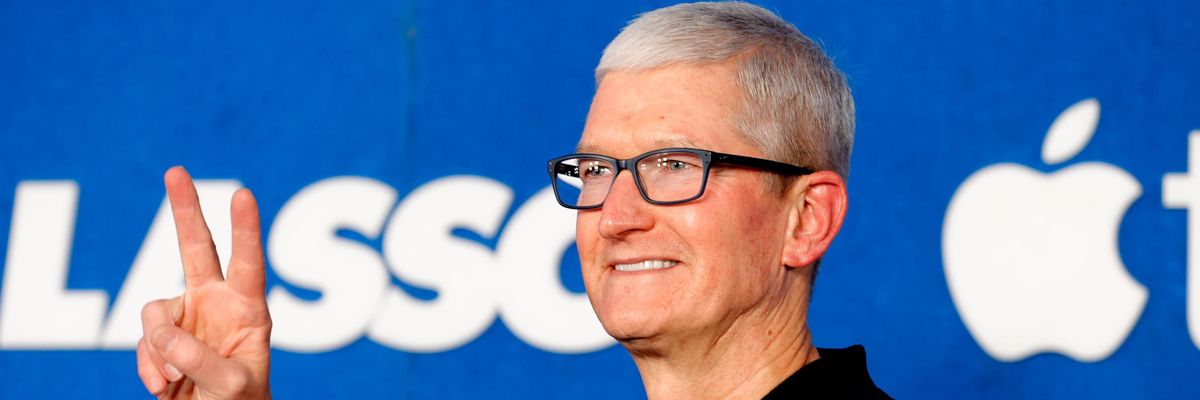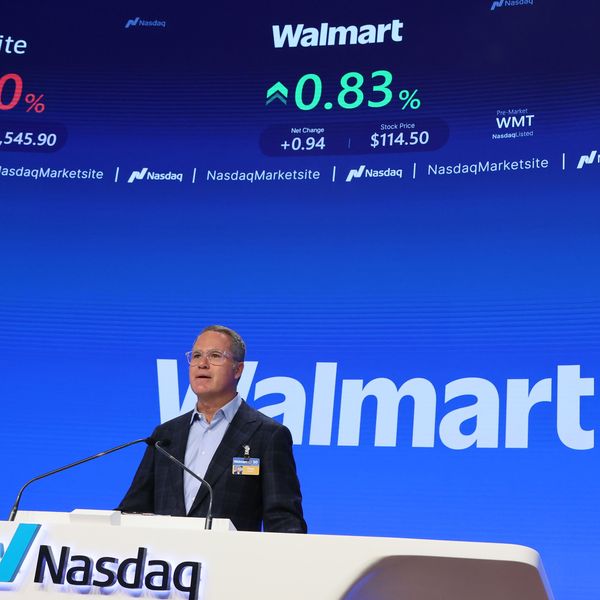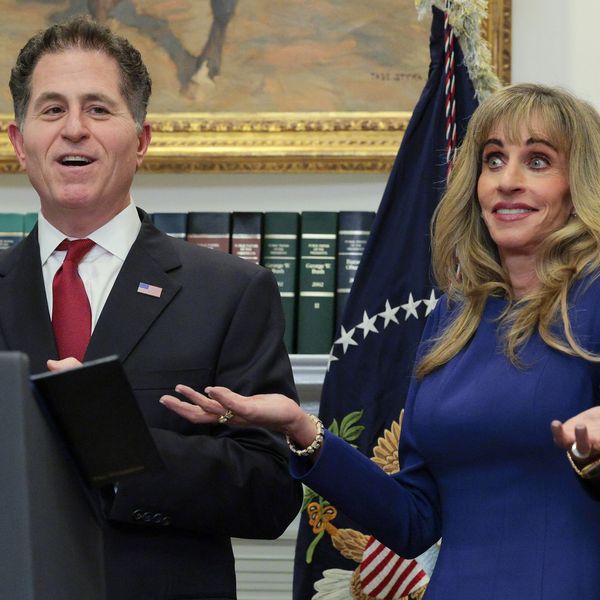
Apple CEO Tim Cook attends an event on July 15, 2021 in West Hollywood, California. (Photo: Frazer Harrison/FilmMagic)
Analysis Shows Top US CEOs Made 254 Times More Than Median Workers in 2021
One expert noted that "workers, many of whom are on the front lines of the crisis, have not been reaping the rewards" of record-breaking corporate profits.
An analysis released Monday shows that the CEOs of some of the largest corporations in the United States made 254 times more than their median employees in 2021 as executive bonuses and stock awards grew significantly.
According to the latest edition of the Equilar 100, an annual report that spotlights executive pay at leading U.S. companies, median total CEO compensation at top firms soared to $20 million in 2021, a nearly 31% increase from 2020.
"A higher minimum wage and unions can put corporate greed in check and raise wages throughout the labor market."
"Increases were seen across all pay components," notes the new analysis, which lists the total compensation and CEO-to-median-employee pay ratio of the 100 largest U.S. companies by revenue, a ranking that includes Apple, Microsoft, Raytheon, and Intel.
"While median salary and median perks increased incrementally, the largest jumps were examined in the form of cash bonuses and stock awards," the analysis notes. "The median value of stock awards increased by 22.7% in 2021, from $8.6 million to $10.5 million. Meanwhile, cash bonuses increased by 46.4% in 2021, from $2.8 million to $4.2 million."
Intel CEO Pat Gelsinger topped the Equilar 100 list with $177.9 million in total compensation in 2021 followed by Apple CEO Tim Cook, who took home $98.7 million last year--a 569% increase from 2020.
Amid record-shattering corporate profits and surging CEO pay, typical workers continued to struggle in 2021 as the coronavirus kept spreading and rising prices of food, housing, and other necessities eroded their modest wage gains. As Bloomberg reported last month, "employee compensation rose 11%" in 2021, "but the so-called labor share of national income--essentially, the portion that's paid out as wages and salaries--fell back to pre-pandemic levels."
Sarah Anderson, director of the Global Economy Project at the Institute for Policy Studies, told CNBC on Monday that the new Equilar study shows corporations "really just let loose in 2021 and were focused on keeping their executives happy and not worrying as much about what was happening on the worker end."
"Workers, many of whom are on the front lines of the crisis, have not been reaping the rewards," said Anderson.
Related Content

'Their Inflation Strategy Is Working': Corporate Profits Soared to Record High in 2021
Equilar's findings provide further evidence that the decades-long trend of soaring CEO compensation and largely stagnant worker pay is persisting as legislative efforts to narrow the gap go nowhere. According to the Economic Policy Institute (EPI), CEO pay in the U.S. rose 1,322% between 1978 and 2020 while typical worker pay grew just 18%.
On Tuesday, EPI and Harvard University's Shift Project released a Company Wage Tracker that uses survey data to show employee wage distributions at nearly 70 large retail and food-service companies, including Starbucks, Dollar General, Walmart, McDonald's, and other prominent corporations.
"At Starbucks--where workers have sparked a union organizing wave in recent months--63% of workers make below $15 an hour," EPI notes. "At Dollar General and McDonald's, 92% and 89% of workers, respectively, make below $15 an hour, with nearly one-in-four workers making below $10 an hour at both companies. A majority (51%) of workers make below $15 an hour at Walmart."
Ben Zipperer, an economist at EPI, said in a statement that "low wages are a defining feature of the U.S. labor market, and the service sector in particular."
"Low pay is not limited to 'mom-and-pop' stores--it is also widespread in big box stores, restaurants, and grocery stores that often have high CEO pay and revenue," Zipperer added. "A higher minimum wage and unions can put corporate greed in check and raise wages throughout the labor market."
An Urgent Message From Our Co-Founder
Dear Common Dreams reader, The U.S. is on a fast track to authoritarianism like nothing I've ever seen. Meanwhile, corporate news outlets are utterly capitulating to Trump, twisting their coverage to avoid drawing his ire while lining up to stuff cash in his pockets. That's why I believe that Common Dreams is doing the best and most consequential reporting that we've ever done. Our small but mighty team is a progressive reporting powerhouse, covering the news every day that the corporate media never will. Our mission has always been simple: To inform. To inspire. And to ignite change for the common good. Now here's the key piece that I want all our readers to understand: None of this would be possible without your financial support. That's not just some fundraising cliche. It's the absolute and literal truth. We don't accept corporate advertising and never will. We don't have a paywall because we don't think people should be blocked from critical news based on their ability to pay. Everything we do is funded by the donations of readers like you. Will you donate now to help power the nonprofit, independent reporting of Common Dreams? Thank you for being a vital member of our community. Together, we can keep independent journalism alive when it’s needed most. - Craig Brown, Co-founder |
An analysis released Monday shows that the CEOs of some of the largest corporations in the United States made 254 times more than their median employees in 2021 as executive bonuses and stock awards grew significantly.
According to the latest edition of the Equilar 100, an annual report that spotlights executive pay at leading U.S. companies, median total CEO compensation at top firms soared to $20 million in 2021, a nearly 31% increase from 2020.
"A higher minimum wage and unions can put corporate greed in check and raise wages throughout the labor market."
"Increases were seen across all pay components," notes the new analysis, which lists the total compensation and CEO-to-median-employee pay ratio of the 100 largest U.S. companies by revenue, a ranking that includes Apple, Microsoft, Raytheon, and Intel.
"While median salary and median perks increased incrementally, the largest jumps were examined in the form of cash bonuses and stock awards," the analysis notes. "The median value of stock awards increased by 22.7% in 2021, from $8.6 million to $10.5 million. Meanwhile, cash bonuses increased by 46.4% in 2021, from $2.8 million to $4.2 million."
Intel CEO Pat Gelsinger topped the Equilar 100 list with $177.9 million in total compensation in 2021 followed by Apple CEO Tim Cook, who took home $98.7 million last year--a 569% increase from 2020.
Amid record-shattering corporate profits and surging CEO pay, typical workers continued to struggle in 2021 as the coronavirus kept spreading and rising prices of food, housing, and other necessities eroded their modest wage gains. As Bloomberg reported last month, "employee compensation rose 11%" in 2021, "but the so-called labor share of national income--essentially, the portion that's paid out as wages and salaries--fell back to pre-pandemic levels."
Sarah Anderson, director of the Global Economy Project at the Institute for Policy Studies, told CNBC on Monday that the new Equilar study shows corporations "really just let loose in 2021 and were focused on keeping their executives happy and not worrying as much about what was happening on the worker end."
"Workers, many of whom are on the front lines of the crisis, have not been reaping the rewards," said Anderson.
Related Content

'Their Inflation Strategy Is Working': Corporate Profits Soared to Record High in 2021
Equilar's findings provide further evidence that the decades-long trend of soaring CEO compensation and largely stagnant worker pay is persisting as legislative efforts to narrow the gap go nowhere. According to the Economic Policy Institute (EPI), CEO pay in the U.S. rose 1,322% between 1978 and 2020 while typical worker pay grew just 18%.
On Tuesday, EPI and Harvard University's Shift Project released a Company Wage Tracker that uses survey data to show employee wage distributions at nearly 70 large retail and food-service companies, including Starbucks, Dollar General, Walmart, McDonald's, and other prominent corporations.
"At Starbucks--where workers have sparked a union organizing wave in recent months--63% of workers make below $15 an hour," EPI notes. "At Dollar General and McDonald's, 92% and 89% of workers, respectively, make below $15 an hour, with nearly one-in-four workers making below $10 an hour at both companies. A majority (51%) of workers make below $15 an hour at Walmart."
Ben Zipperer, an economist at EPI, said in a statement that "low wages are a defining feature of the U.S. labor market, and the service sector in particular."
"Low pay is not limited to 'mom-and-pop' stores--it is also widespread in big box stores, restaurants, and grocery stores that often have high CEO pay and revenue," Zipperer added. "A higher minimum wage and unions can put corporate greed in check and raise wages throughout the labor market."
An analysis released Monday shows that the CEOs of some of the largest corporations in the United States made 254 times more than their median employees in 2021 as executive bonuses and stock awards grew significantly.
According to the latest edition of the Equilar 100, an annual report that spotlights executive pay at leading U.S. companies, median total CEO compensation at top firms soared to $20 million in 2021, a nearly 31% increase from 2020.
"A higher minimum wage and unions can put corporate greed in check and raise wages throughout the labor market."
"Increases were seen across all pay components," notes the new analysis, which lists the total compensation and CEO-to-median-employee pay ratio of the 100 largest U.S. companies by revenue, a ranking that includes Apple, Microsoft, Raytheon, and Intel.
"While median salary and median perks increased incrementally, the largest jumps were examined in the form of cash bonuses and stock awards," the analysis notes. "The median value of stock awards increased by 22.7% in 2021, from $8.6 million to $10.5 million. Meanwhile, cash bonuses increased by 46.4% in 2021, from $2.8 million to $4.2 million."
Intel CEO Pat Gelsinger topped the Equilar 100 list with $177.9 million in total compensation in 2021 followed by Apple CEO Tim Cook, who took home $98.7 million last year--a 569% increase from 2020.
Amid record-shattering corporate profits and surging CEO pay, typical workers continued to struggle in 2021 as the coronavirus kept spreading and rising prices of food, housing, and other necessities eroded their modest wage gains. As Bloomberg reported last month, "employee compensation rose 11%" in 2021, "but the so-called labor share of national income--essentially, the portion that's paid out as wages and salaries--fell back to pre-pandemic levels."
Sarah Anderson, director of the Global Economy Project at the Institute for Policy Studies, told CNBC on Monday that the new Equilar study shows corporations "really just let loose in 2021 and were focused on keeping their executives happy and not worrying as much about what was happening on the worker end."
"Workers, many of whom are on the front lines of the crisis, have not been reaping the rewards," said Anderson.
Related Content

'Their Inflation Strategy Is Working': Corporate Profits Soared to Record High in 2021
Equilar's findings provide further evidence that the decades-long trend of soaring CEO compensation and largely stagnant worker pay is persisting as legislative efforts to narrow the gap go nowhere. According to the Economic Policy Institute (EPI), CEO pay in the U.S. rose 1,322% between 1978 and 2020 while typical worker pay grew just 18%.
On Tuesday, EPI and Harvard University's Shift Project released a Company Wage Tracker that uses survey data to show employee wage distributions at nearly 70 large retail and food-service companies, including Starbucks, Dollar General, Walmart, McDonald's, and other prominent corporations.
"At Starbucks--where workers have sparked a union organizing wave in recent months--63% of workers make below $15 an hour," EPI notes. "At Dollar General and McDonald's, 92% and 89% of workers, respectively, make below $15 an hour, with nearly one-in-four workers making below $10 an hour at both companies. A majority (51%) of workers make below $15 an hour at Walmart."
Ben Zipperer, an economist at EPI, said in a statement that "low wages are a defining feature of the U.S. labor market, and the service sector in particular."
"Low pay is not limited to 'mom-and-pop' stores--it is also widespread in big box stores, restaurants, and grocery stores that often have high CEO pay and revenue," Zipperer added. "A higher minimum wage and unions can put corporate greed in check and raise wages throughout the labor market."

